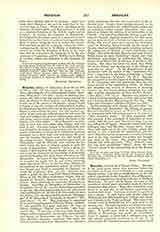

Heraclas, Bishop of Alexandria from 231 or 232; to 247 or 248. Of his earlier life Origen tells us, when defending his own philosophical studies (Eusebius, “Hist. Eccl.”, VI, xix): “In this we imitated Pantaenus, who before our day assisted many and had no little knowledge of these matters, and Heraclas, who is now one of the priests of Alexandria, whom I found a hearer of my own teacher of philosophical studies, for he had already been with him for five years before I began to attend these lectures. On this teacher’s account he put aside the ordinary dress he had worn till then, and assumed the garb of a philosopher, which he still wears, and he ceases not to study the books of the Greeks with all his might.” Thus Heraclas was probably at least five years older than Origen, who was born in 185. Yet when Origen in his eighteenth year was obliged by his father’s martyrdom and the consequent confiscation of his goods to commence teaching grammar (for a short time) and philosophy, Heraclas and his brother Plutarch were the first pupils of the young teacher. Origen converted them both to Christianity, and St. Plutarch soon suffered for the faith, being the first of Origen’s pupils to gain the crown of martyrdom. Heraclas “gave a great example of philosophical life and askesis (ibid., vi, 33), and it was his reputation for knowledge of philosophy and Greek learning that drew Julius Africanus to visit Alexandria. In course of time Origen found his day so occupied by pupils that he had scarce breathing space from morn till eve, so that he chose Heraclas as his assistant in the catechetical school (of which he was himself now head in succession to Clement), to teach the beginners (ibid., vi, 15). Heraclas was made a priest by the long-lived Bishop Demetrius. When in 231 the latter condemned Origen, who remained at Caesarea, Heraclas became head of the school. Soon afterwards he succeeded Demetrius as bishop. According to Theophilus of Alexandria (in Gennadius, “De vir. ill.”, xxxiv), when Origen returned to the city, Heraclas deposed him from the priesthood and banished him (cf. the life of St. Pachomius in Acta SS., May 14, § 21, and the probably spurious “Mystagogia” of St. Alexander of Alexandria, in Routh’s “Reliquiae Sacrae” IV, 81). This statement is supported by an interesting fragment of Photius (Sunag ¬? kai apod., 9), who probably had good authority. It runs as follows (Dollinger, “Hippol. and Kallist.”, 264, Engl. transl. 245): “In the days of the most holy Heraclas, Origen, called Adamantius, was plainly expounding his own heresy on Wednesdays and Fridays; the said holy Heraclas therefore separated him from the Church and drove him from Alexandria, as a distorter of the wholesome doctrine and a perverter of the orthodox faith. Origen, thus excommunicated, on his way to Syria reached a city called Thmuis, which had an orthodox bishop named Ammonius, who committed to Origen the delivery of an instruction in his Church. The said Pope Heraclas, having heard this, went to Thmuis, deposed Ammonius for this cause, and set up in his stead as bishop a younger man named Philip, who was of great note among the Christians. Later on, Heraclas, being besought by the people of the city, received Ammonius again as bishop, and gave the episcopate of Thmuis to both Ammonius and Philip. But after the holy Heraclas had gone thence, Philip never sat upon the bishop’s throne, but when Ammonius expounded or celebrated the liturgy, always stood behind him all the days of the life of Ammonius. But when the latter was dead, then Philip sat on the throne, and became one of the bishops remarkable for virtue.” On the identification of this Ammonius with the author of the “Ammonian Sections“, mentioned in the letter of Eusebius to Carpianus, see Harnack, “Chronol.”, II, 81-2. Heraclas was succeeded in the third year of the Emperor Philip, by St. Dionysius, who had previously been his successor as head of the catechetical school. St. Dionysius describes the custom of Heraclas in receiving heretics into the Church without rebaptism, but only after a public examination of their conduct (Euseb., “Hist. Eccl.”, VII, vii, 4). Heraclas was inserted by Usuard in his martyrology on July 14, and he has thus come into the Roman Martyrology on that day. The Copts and Ethiopians celebrate his feast on December 4
On the testimony of St. Jerome (Ep. xlvi) that “until Heraclas and Demetrius” the bishops of Alexandria were ordained by priests, see Egypt (V). The latest discussion (with full bibliography) is by Cabrol in “Dict. d’archeol. chret.”. In close connection with this question is the statement of Eutychius of Alexandria (933-40) that until Demetrius there was but one bishop for all Egypt; Demetrius established three suffragan sees, and Heraclas twenty more. Eutychius adds that one of the new bishops, named Eumenius (is this a mistake for Ammonius?), fell into error; Heraclas; having summoned a council of bishops, went to his city, examined the matter and brought him back to the truth. The people, hearing the bishops call their patriarch “Aba” (Father), entitled him their grandfather “Baba”, hence the title “Papas” given to the Alexandrian as to the Roman bishop.
JOHN CHAPMAN

